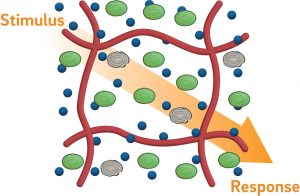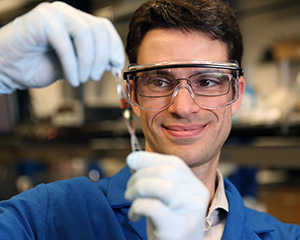IRG 2: Engineered Living Materials
 The intellectual focus of IRG 2: Engineered Living Materials is to develop methods to integrate engineered living matter with polymeric materials. In doing so, we will create new composite materials that are responsive to diverse stimuli and capable of generating complex, genetically encoded material outputs. Our long-term research goals are to develop techniques that will enable the creation of materials at the living/non-living interface, with the potential for use in biosynthetic electronics, chemical threat decontamination, therapeutic synthesis/delivery, and soft robotics, among other applications. To accomplish these goals, we will integrate genetically-modified photosynthetic organisms (e.g., cyanobacteria, plant cells, and algae) with polymeric materials through gel immobilization, patterning on flexible/elastomeric substrates, or deposition onto mechanically robust films. Within these materials, genes will be activated in response to a specific stimulus that will control material properties. Our proposed research goes beyond bio-mimetic or bio-inspired materials; living systems and polymeric materials will be synergized to achieve unprecedented control of material properties and function in the emerging area of engineered living materials. Fundamental challenges inherent to living materials will be pursued in the context of three research thrusts:
The intellectual focus of IRG 2: Engineered Living Materials is to develop methods to integrate engineered living matter with polymeric materials. In doing so, we will create new composite materials that are responsive to diverse stimuli and capable of generating complex, genetically encoded material outputs. Our long-term research goals are to develop techniques that will enable the creation of materials at the living/non-living interface, with the potential for use in biosynthetic electronics, chemical threat decontamination, therapeutic synthesis/delivery, and soft robotics, among other applications. To accomplish these goals, we will integrate genetically-modified photosynthetic organisms (e.g., cyanobacteria, plant cells, and algae) with polymeric materials through gel immobilization, patterning on flexible/elastomeric substrates, or deposition onto mechanically robust films. Within these materials, genes will be activated in response to a specific stimulus that will control material properties. Our proposed research goes beyond bio-mimetic or bio-inspired materials; living systems and polymeric materials will be synergized to achieve unprecedented control of material properties and function in the emerging area of engineered living materials. Fundamental challenges inherent to living materials will be pursued in the context of three research thrusts:

Stimuli-Responsive Biosynthetic Materials. Fabricate biosynthetic composite materials by integrating engineered cells into gels, 3D-printed structures, and elastomers to develop materials that are chemical factories. Current stimuli-responsive materials lack a diversity of inputs and consequently respond with modest material outputs. We will create materials that respond genetically to specific, diverse stimuli—e.g., chemical threat exposure, circadian cycle, and disease states—and produce a range of outputs, including threat deactivation, cyclical thermal insulation, and triggered therapeutic production, respectively.
Photosynthetic Electronic Materials. Pattern and synthesize polymer electronic materials using photosynthetic organisms. Engineered cells offer the ability to perform complex biosynthetic chemistry to form monomers for conducting polymers (e.g., thiophene or pyrrole), as well as oxidative polymerization catalysts (e.g., peroxidases). We will engineer plant cells, cyanobacteria, and algae to synthesize these components in response to light (optogenetics). These cells will be integrated into polymeric substrates by roll-to-roll manufacturing, gel encapsulation, and soft-lithography to yield biocomposite materials that can be photolithographically patterned into electronic circuits.
Auto-Regenerative and Shape-Shifting Materials. A single-step genetically controlled polymerization will be initiated by engineered cells to achieve auto-regeneration of damaged materials and material folding (i.e., polymer origami). Genetically engineered cells that produce olefin monomers and metal-free catalysts for controlled radical polymerization (CRP) will be incorporated into polymeric materials. Once activated, the engineered cells will produce all requisite material for CRP that will produce polymers with diverse mechanical properties. We anticipate using these composites to heal material damage (i.e., auto-regeneration) and to induce complex geometric changes by generating asymmetric forces through differences in mechanical properties.







